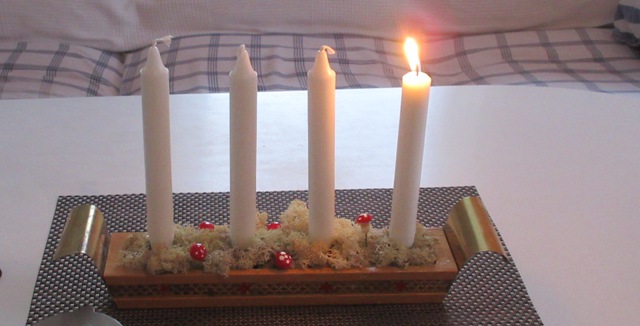A tradition still followed by many Swedes is the ritual of ‘adventskaffe’, or having coffee sitting calmly by your advent candles. There are four candles in a row, and on the second Sunday two of them are lit, and so on, until at Christmas four are lit. The result of this ritual, if you follow it correctly, is that your candles burn down in a diagonal line, with the candle of the fourth Sunday still long while the candle lit on the first Sunday has burnt very short. (Those upside down ‘v’ shaped electric lights very popular in windows at Christmas in lots of countries are based on this – though the diagonal lines go in two directions.)
At the base of the candles are decorations of moss, and red-spotted mini-mushrooms. I suppose this is meant to look like the forest floor, though the red-spotted mushrooms are very kitsch-looking and wouldn’t fool anyone. The moss, however, is real. It’s off-white coloured, clumpy and soft, and sits there very well supporting the ridiculous fairy mushrooms.
You can buy this moss in small packets in supermarkets. They’re in small packets because whereas in Sweden there is generally a legal right to pick things in the wild, this kind of moss is restricted. It’s very slow-growing for one thing, and for another, in this part of Sweden, it’s a primary source of food for reindeer. It contains protein (3%), fat (2.7%), fibre (21.8%), and sugars and starch (65%). A complete meal, just waiting there under the snow – provided there isn’t a layer of ice on top (that’s the problem of warmer temperatures coming after snow).
The truly amazing thing about this moss is, it’s everlasting. Provided the reindeer don’t eat it. When I say ‘everlasting’ I mean, it lasts as long as I can remember where I’ve kept it, which might mean five years so far. Each year I pack away the cut moss, in an airtight bag with a little moisture, and the next year I unpack it and – hey presto! – moss good as new, ready to go. There’s no residual smell in the bag either – just a slight aroma of moss.
When it’s out in the warm air of the house it begins to dry out, and so by the end of Christmas, if you haven’t added water, it’s hard. But just add water and it springs back. You have to remember, this moss is dead. It’s cut moss, no connection to anything to sustain it.
It’s actually called ‘fönstermossa’, which translates as ‘window moss’. I tried to imagine where it had got that name. It’s full of holes, so perhaps it’s because you can see through it? I looked it up and it’s actually because before they learnt to manufacture airtight double glazed windows people put this moss between the panes of glass to soak up the humidity and keep the windows clear of fog.
It is really remarkable, and – I find – rather consoling. You can always rely on last year’s moss.


